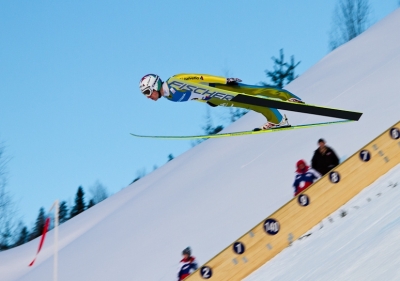
When the 18-year-old Austrian Sepp Bradl became the first person to ski-jump more than 100m (328ft) in 1936, the engineer who had designed the jump – in Planica, Yugoslavia – shouted: ‘That was not ski-jumping. That was ski-flying!’
It was true. A new sport had been born, in which the skiers had to develop a totally new skill, turning themselves into aerofoils. Their ability to win now depends less on jumping than on flying. As he glides through the air, the skier leans forward with his body slightly curved. The same aerodynamic forces that keep an aeroplane flying help the ski-jumper to remain in the air longer and travel farther. The air passes over his curved back faster than under his front, creating a partial vacuum which causes lift.
Since Bradl’s 100m jump, the world record has been almost doubled, to 180 m (590ft) in 1989.
Sky jumpers start learning at practically any age. First, the jumper learns how to build up speed. This is done on a normal ski slope. The skier crouches down in a position that minimises air resistance, with the arms are swept back. World-class jumpers take off at up to 60mph (100km/h).
Before making his first real jump, in the skier must know how to land. He learns to touch down with 1 foot slightly in front of the other, and the knees bent.
Fledgling skiers buildup experience by making small jumps from low banks or platforms. This teaches them to cope with the takeoff. If balance is wrong on take off – in particular, if the weight is too far back – wind will flip the jumper over.
The true glory of ski-jumping is the flight itself. The beginner‘s first real jump will probably carry him about 10 m (30ft). Only when they become teenagers are most children able to make jumps of 40 m (130ft), for which they must adopt the true aerofoil position.
The flight itself is a complex operation. As he loses his horizontal motion, the jumper contracts his body a little, ready to meet the slope beneath him. As he falls, he loses speed but bends forward, and with skill can extend his glide.
In-flight, perhaps the greatest danger of all comes from wind. However, although injuries happen, fatalities are there.
Picture Credit : Google
